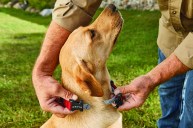Ticks. Every pet owner knows them, fears them, and despises them. These pesky, blood-sucking critters are not only annoying and disgusting but can carry a myriad of diseases as well. The worst part about them is that they are so small and can easily hide on your dog. Luckily, they are creatures of habit and they have their favorite spots. So, if you are worried about ticks this season here are the top 9 hiding spots that ticks love on dogs.
Favorite Hiding Spots For Ticks On Dogs

Pexels: Thierry Rossier
While ticks can be found anywhere on your pet, they definitely have their preferences. Here are the top 9 hiding spots for ticks on dogs. These are the most common areas that you will find these parasitic arachnids.
Head And Neck
This area is a common hiding spot for ticks on dogs simply because dogs are always putting their head and faces into places. When they are out on a walk exploring they stick their face into things to sniff and check it out. In that time that your dog's head is in the grass sniffing, the tick could latch on. Similarly, 4 Paws Veterinary Care shares that "Many pets have scruff of fur around their necks." That scruff makes a great hiding spot for ticks to burrow, so be sure to check there.
Between The Toes
While this seem like a bizarre place it is one of the most common. Those adorable little toe beans are on the ground, making them easy access for ticks. Similarly, in between the toes is a great place to hide for the tick. They are kept safe and sound while they latch on. Ticks can also be found on the bottom of your dog's paw, near the pads.
Tail

Pexels: Elina Volkova
Nothing makes a tick happier than an underside of a tail. There is is dark and moist, which is the perfect environment for a tick. This hiding spot for ticks on dogs is particularly prominent near the base of the tail. Seeing as most owners are not regularly lifting their dogs tails and checking underneath, ticks often go here unnoticed for quite some time.
Groin
Here is an area that is very common for ticks and often goes unchecked because let's be honest...no one is super keen on checking their dog's genital regions. However, it is another dark, warm, and moist region of your pet's body so the ticks are drawn to it.
In And Around The Ears
This region is especially popular if you have a dog with floppy ears. Ticks love ears! They can be found on them, behind them, or even inside of them. Ears are warm and dark offering the perfect sanctuary for ticks. Additionally, they are attached to the head and neck which are other favorite hiding spots of ticks on dogs.
Near The Eyelids
While this one may be surprising, it is no less common. Ticks here are often mistaken for skin tags, because dogs often grow skin tags around this area of their body. The danger in this is that due to the confusion, ticks in this region are often left alone. Thus allowing them to stay attached for awhile, meaning they are more likely to spread disease to your pet.
Under The Collar

Image via YouraPechkin/Shutterstock
While you should already be checking your dog's neck do not forget to look under the collar as well. Many pet owners choose to keep their dog's collars on all the time, but that leaves ticks the perfect hiding spot. In fact, initially the tick may be attached to the collar rather than your dog. So if you just check the neck and not the collar you may miss it, and eventually the tick will move from the collar to your dog's throat.
On Their Legs
Like their toes, your dog's legs are often closer to the ground and wading through the tall grasses. Ticks like to hide where your dog's legs meet their body. That small area in skin is like our armpits. It is dark, warm and difficult for your dog to disturb the tick.
The Underbelly
Similar to the groin area, ticks will also gravitate towards other areas of your dog's underbelly. This area is easily accessible as they wade through tall grasses and vegetation. While they may gravitate towards the groin areas, ticks can easily be found along the entire underbelly as well.
How To Check Your Dog For Ticks

Pexels image by Ron Lach
When checking your dog for ticks, you want to be thorough. Do not leave one body part unchecked as these parasitic arachnids love to hide. When checking the head be sure to pay attention to your dog's clues. The American Kennel Club shares that if your dog is shaking their head a lot it could mean there is something there that is irritating them.
Similarly, they may be scratching at their ears. When checking the ears, be sure to look deep inside. Ticks do not just lounge around the surface or outer edges, sometimes they go within the ear. In regards to the feet, notice if your dog is licking or chewing their feet, that could be a sign something is irritating them.
Be sure to separate the toes and look between each toe for ticks as well as on the bottom pads. Wiping your dog's feet after a walk can help you notice any ticks hiding on your dogs as well as clean them. Furthermore, you want to be sure to check under your dog's tail. Lift the tail and check the underside as that is the common area for ticks to hide. If your dog has thick fur be sure to comb through it to dislodge any ticks that may be hiding there.
The Inspection Continues
Although it will be your least favorite part of the check, be sure to check your dog's groin area as well. This is a definite favorite hiding spot of ticks on dogs. Be sure to carefully inspect around your pet's eyelids as ticks often hide here and get mistaken for skin tags. If you notice something their after a walk that wasn't there before it could be a tick.
After time outdoors it is important to remove your dog's collar and inspect it thoroughly for ticks. Once it has been cleaned and proven to be tick-free you may place it on your dog's neck again. Also, don't forget about your pet's "armpits." Those spaces where your dog's legs meet their body is a favorite hiding spot of ticks on dogs.
Be sure to do thorough inspections when coming home from being outside. Brush your dog thoroughly, frequent baths, and check all of the favorite hiding spots of ticks on dogs.




